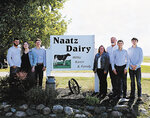
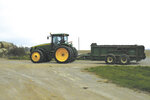
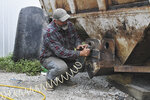
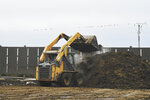
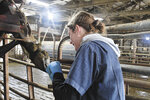
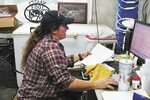
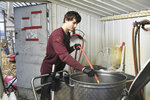
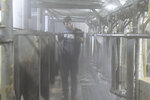
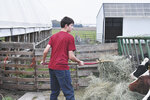
MANTORVILLE, Minn. — Each day has its own routine at Naatz dairy whether it is herd check, vaccinations or drying off cows.
Willie and Karen Naatz and their sons — Tristin, Trace, Brodee and Wyatt — milk 250 cows on 70 acres of owned and rented land near Mantorville.
On Thursday, Oct. 19, the day began at 2:30 a.m. in the barn, and by 3 a.m., Karen and Tristin were putting milkers on cows in their double-10 parlor.
The farm’s weekly routine begins every Monday, when the Naatzes dry off cows and give Lutalyse shots. Tuesdays, they sand bed their free stalls, give their heifers vaccinations, and give their dry cows vaccinations and move them.
Wednesdays, they culture milk samples from fresh cows and cows with high somatic cell counts for the veterinarian. Thursdays are slated for giving more breeding shots and sorting cows for herd-check day.
Fridays, they give breeding shots and cow vaccinations. Saturdays, they give GnRH shots and do any tasks that were missed earlier in the week. Sunday is their breeding day; they have professionals from Select Sires do all their breeding.
Willie, Karen, Tristin and Brodee are all full time on the dairy farm, and Wyatt and Trace help out when their other responsibilities allow time. Wyatt is a freshman and attends high school online, and Trace is preparing to go to medical school and is a medic for Dodge Center Ambulance Services. In addition to dairy farming, Tristin has a custom baling business. Brodee helps him in the business by doing raking.
Some of the things Karen said she likes about the farm are her freedom to set her own schedule and her opportunity to raise her kids there.
Willie agreed.
“(You) don’t make much money, (but it’s) a good way to raise kids and give them a good work ethic,” he said.
Willie and Karen are middle school sweethearts who married at ages 18 and 19.
Besides family working on the farm, the Naatzes also have one full-time and four part-time employees.
The Naatz family milks twice a day for their regular herd, but fresh cows are milked four times a day. To accomplish this, the fresh cows are milked both at the beginning and the end of every milking.
That Thursday, at 7 a.m. in the calf barns, Brodee was starting to feed calves and Wyatt was giving grain and hay. Calf feeding took about an hour. The Naatz family uses a portable milk dispenser. Calves are fed using bottles until weaning, but they also have water in buckets. Currently, the Naatzes have over 30 calves on milk.
At a little after 7 a.m., Ian Thomas, a milk quality specialist from Leedstone, was in the milking parlor, testing the pulsators and preparing to check the wash cycle of the milkers once milking was completed.
By 7:40 a.m., milking was wrapping up, and Karen and Tristin started cleaning. A little after 8 a.m., Karen was in the office, printing off lists for herd check from DairyComp and checking over CowManager.
At 8:20 a.m., Dr. Amy Dahlke, of Anderson Veterinary Services, arrived to do the weekly herd check. Karen said they do weekly herd checks to help stay on top of breeding and any health issues.
The check started with pregnancy checks before moving on to the fresh cows. Dahlke finished by checking on a hoof of a lame cow, completing the herd check around 10 a.m.
While herd check was going on with Karen and Tristin, Brodee was cleaning manure off of a lot and getting fresh bedding down. He spent most of the rest of the day hauling manure.
Once herd check was complete, Karen and Tristin entered information into DairyComp and then headed to the house for breakfast and a break around 11 a.m.
At 10 a.m., Willie began mixing the total mixed ration for the day. He mixes four batch-es every day. The Naatz family uses baleage, corn silage, dry hay, NovaMeal and a custom mix of corn and minerals. The Naatzes purchase most of their feed, including buying corn silage from neighbors. That afternoon, Willie wrapped up most of his mixing by 2 p.m.
At 2:15 p.m., Karen and Tristin were starting to get calves bedded. Their calves are housed in hutches and in a calf barn. Calves stay on their farm until 5 months of age when they are taken to a custom heifer raiser.
Once calf bedding was done, Karen was in the house, doing bookwork and making supper, and Tristin and Willie were working on the manure spreader project Willie had started earlier in the afternoon. They finished around 4 p.m.
At 3:30 p.m., employees arrived for evening milking, and by 4 p.m., milkers were going on cows. Evening milking is done by employees.
While milking was happening, Willie worked on scraping the barns, adding more sand and grooming the free stalls. The barns are scraped in three sections, so he scraped at 4 p.m., 5 p.m. and 6 p.m. In between scraping the barn, he mixed feed for the dry cows. Finally, he pushed up feed before going in for supper at 6:45 p.m.
Karen and Wyatt fed calves at 6 p.m. There was a new calf born, which meant extra work for the calf feeders and milkers.
Fresh cows that are not heifers receive Bovikalc and Inforce 3. The Naatzes test the colostrum with a Brix scale. Any colostrum over 22 is bagged and pasteurized. New calves are fed colostrum, tagged and dehorned.
By 7:45 p.m., Karen and Wyatt were in for the evening. Employees completed milking by 9:30 p.m.
Comments
No comments on this item Please log in to comment by clicking here